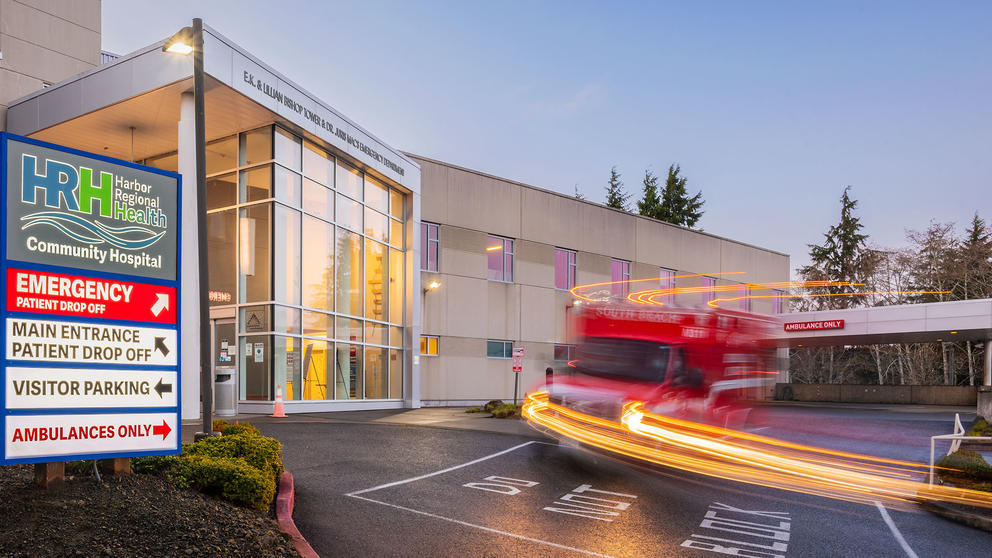Medical institutions are working on solutions, but many are systemic changes whose effect may not be clear for years. One upstream solution was the 2017 opening of Washington State University’s Elson S. Floyd College of Medicine in Spokane, a medical school focused on placing new physicians in the state’s underserved rural areas.
Training in other disciplines is also helping. Pacific Northwest University of Health Sciences trains future osteopathic clinicians in the Yakima Valley with an emphasis on serving rural communities. And other healthcare workers like physician assistants and advanced registered nurse practitioners can fill some gaps around the state.
From left, students Lulu Duffy, Lilly Hennessey, Samantha Hill, Nate Savolainen and Shahroz Tariq review test results from a CLINITEK Status+ urine analyzer during an Art and Practice of Medicine first-year class at the Elson S. Floyd College of Medicine at Washington State University Spokane, Tuesday, Jan. 23, 2024. (Young Kwak for Cascade PBS)
Telehealth is also making a difference. But training physicians can take a decade or more, and not all kinds of care translate well to a virtual space. In the meantime, patients face major disparities in access to basic — and sometimes urgent — care between urban and rural Washington, and between east and west.
A recent WSU study published in Alzheimer’s & Dementia: The Journal of the Alzheimer’s Association found that one of these impacted areas is dementia treatment. Using the death records of almost 95,000 Washingtonians who died of Alzheimer’s disease or other dementias between 2011 and 2021, researchers found that people in urban regions lived an average of nine miles from a neurologist. That distance increased the farther patients lived from urban centers: 45 miles in suburban communities, 88 miles in small towns, and 100 miles in rural areas — distances that can keep people from being seen by a neurologist at all.
The study also noted racial disparities, with longer distances to a neurologist for Native American (about 28 miles) and Hispanic Washington residents (about 22 miles). Distances for patients in other racial groups were seven to 17 miles. And the researchers connected these distances to disparities in outcomes, including quality of life and the speed of cognitive decline.
“As dementia progresses, the need for people to access a physician increases,” said lead researcher Solmaz Amiri in a statement released with the findings. “To these people, even 17 miles is a large distance that presents a significant burden, so you can imagine how hard it would be to have to travel 100 miles to see a neurologist.”
Disparities in health care access between urban and rural areas can be especially problematic for degenerative conditions like dementia, because delayed diagnosis and treatment “can result in higher costs of care, reduced chances of preserving cognitive function and lower quality of life for dementia patients,” the researchers found.
Some of the study’s proposed solutions — like bringing neurology practices and providers to rural areas — aren’t easy or quick fixes, but one actionable approach would be to adapt dementia care to telehealth or mobile clinics. Amiri also suggested increased training for primary care physicians already working in rural communities who provide dementia care as part of their scope of practice but may not have received extensive formal training in it.
While managing many medical conditions does translate well to telehealth, not all kinds of care do. Access to maternity care, for example, has always been inequitably distributed across the state, with patients traveling long distances to receive care throughout pregnancy, labor and delivery. Dr. Cate Cairney of MultiCare Rockwood’s OB/GYN and midwifery clinic at Multicare Deaconess Hospital in Spokane is accustomed to seeing patients from communities outside of the city where she practices. Many come from Idaho.
This was the case well before both the U.S. Supreme Court’s 2022 ruling in Dobbs v. Jackson Women’s Health, which sent decisions about abortion access to the states and resulted in last year’s closures of labor and delivery units at Idaho’s Bonner General Health and Valor Health. Cairney expects the number of Idahoans she serves to grow with the loss of those local providers.
In fact, she said that she has already seen increases in patient numbers and an overall increase in her practice, with a patient population now 1.5 times what it was three to five years ago. But Cairney said the increase can’t be linked to a single factor. It also reflects growth in surrounding communities. It’s “a longstanding access issue, not an acute reaction to a specific law,” she said.
Health care-related travel is a normal part of life in Eastern Washington and western Idaho. Although Dobbs has drawn new attention to travel related specifically to abortion, the experiences of Cairney and her colleagues show that’s not a newly acute problem, or even one linked to specific procedures or treatments, but a region-wide access problem that’s developed over time. Cairney, the site medical manager at Rockwood for nine years, said it has been this way for many years.
“It’s not unusual for us to have patients from the surrounding smaller communities come to Deaconess,” she said. “Sometimes that is because of complications. Sometimes that’s truly because of access in their own community. That goes across the state line for sure to Idaho.”
As with dementia diagnoses, delays in pregnancy, maternity and other reproductive health care can lead to worse patient outcomes: “For miscarriages, I’m concerned that there would be an increased risk of hemorrhage,” said Cairney. “So I’m really glad to be part of a group that’s trying to increase access, to increase the number of providers we have to be able to accept that volume.”
While Idaho’s policy decisions about reproductive health care often mean a higher patient load for Washington providers, research from the University of Washington Center for Health Workforce Studies suggests that incorporating rural communities into training can help build a stronger base of rural providers to begin with.
A recent study of UW School of Medicine graduates found those who received training in underserved rural communities were more likely to work in rural communities after completing their training. The findings “emphasize that educational programs and policies are crucial public health interventions that can promote health equity through proper distribution of health care workers across rural regions of the United States,” wrote the authors in their conclusions.
While building a physician base is one solution, it will take time; in the meantime, telehealth is a more immediate way to address some gaps in care. Few telehealth services have been scrutinized as heavily as medication abortion, which was made available by mail, with remote counseling, during the COVID-19 pandemic; access to mifepristone, one of the drugs that make this possible, is currently at issue as part of an ongoing Supreme Court case and a Washington lawsuit.
But before the Supreme Court took up the mifepristone challenge, researchers at the University of Washington analyzed the impact medication abortion by mail and telehealth had on remote Washington communities. They found Washington women who lived the farthest away from clinics benefited most from telehealth abortion counseling, as did multiracial patients. The findings, published in the Journal of the American Medical Association, show the promise of remote treatment for abortion as a way to address disparities in access, and a potential model for telehealth as a way to bring clinician support and medications into areas where they would otherwise be inaccessible. “Washington’s model could be a template for providing abortion medicines equitably in other states,” said lead author Anna Fiastro in a news release.
Data shows telehealth services for other types of care also benefit patients. A University of Washington Information School study found telehealth services were especially helpful for patients with motor-neuron diseases like ALS, who reported less fatigue after remote care than in-person. Researchers also reported that telehealth benefited people who use assistive communication technology or live in rural areas.
But even in the case of medication abortion, a successful example of remote care, in-person services are still needed for some patients, said Mercedes Sanchez, executive director of Cedar River Clinics, the network of clinics examined in the UW study. And not all patients preferred telehealth when it was an appropriate option: Some wanted a more human experience, something that can’t quite be quantified in a study or statistical analysis or provided outside of an in-person interaction. Given the choice between picking up medication in person or through the mail, said Sanchez, “We were surprised that the majority chose to pick up their pills. We feel they wanted to be able to have a touch point with clinical staff, even if it wasn’t medically necessary.”







